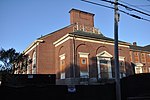Pine Hill (Barnstable County, Massachusetts)
Bourne, MassachusettsMountains of Barnstable County, MassachusettsMountains of Massachusetts

Pine Hill, in Bourne, Massachusetts, United States, is the highest point in Barnstable County and, by extension, Cape Cod. At 306 feet (93 m), it is higher than Dennis's 160-foot (49 m) Scargo Hill, sometimes thought to be the highest on the peninsula, among other local favorites.It is located off Frank Perkins Road, within the Camp Edwards portion of the Massachusetts Military Reservation. Access to it is restricted, not only because it is on a military facility but because it lies at the rear of an artillery range.
Excerpt from the Wikipedia article Pine Hill (Barnstable County, Massachusetts) (License: CC BY-SA 3.0, Authors, Images).Pine Hill (Barnstable County, Massachusetts)
Frank Perkins Road,
Geographical coordinates (GPS) Address Nearby Places Show on map
Geographical coordinates (GPS)
| Latitude | Longitude |
|---|---|
| N 41.708611111111 ° | E -70.565555555556 ° |
Address
Frank Perkins Road
Frank Perkins Road
02542
Massachusetts, United States
Open on Google Maps









